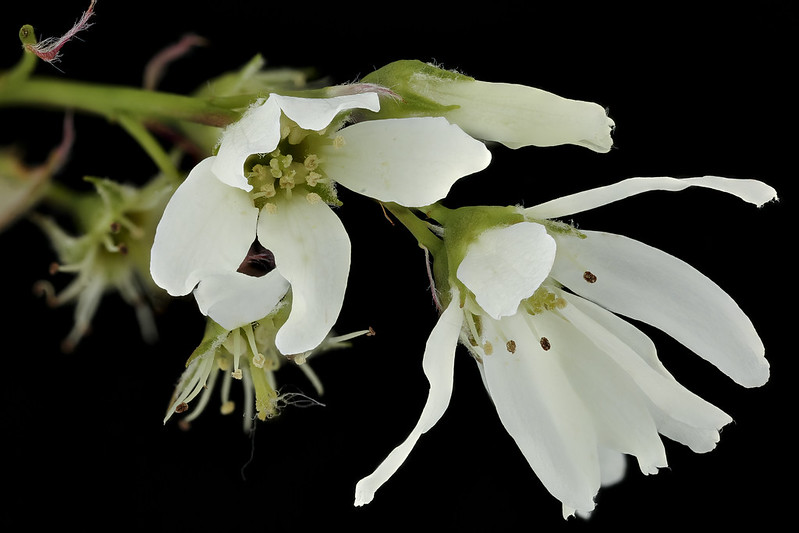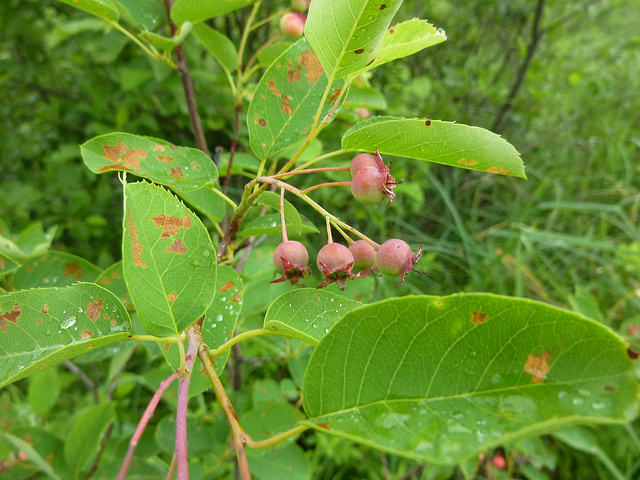Allegheny Serviceberry
(Amelanchier laevis Wiegand)
Description
Allegheny serviceberry (family Rosaceae) is a deciduous tree that can reach heights of 25 feet, and diameters of 25 feet in their native habitats¹. It is a narrow round, multi-stemmed, irregular shape with fragrant white flowers on its fine branches making it a popular plant used in landscaping¹. The bark is smooth, silver-gray, with vertical stripes down it. The leaves are oval shaped, 2-4 inches in length, simple, alternate, and emerge red, before turning green/blue². During the fall, colors change and vary between colors from yellow to red. Loose clusters of white fragrant flowers emerge in April to June7 before the leaves followed by berries in the summer that turn from red to purple and are edible. The berries are round, small, and roughly 3/8 of an inch in diameter1,2.
 Allegheny serviceberry flowers. @H. L. Metzman, 2019 6.
Allegheny serviceberry flowers. @H. L. Metzman, 2019 6.

Allegheny serviceberry leaves and fruits. @ J. Hill, 2015 6
Distribution
Allegheny serviceberries are native to Eastern North America, and Eastern Canada4. Its native habitat is cool woods, in a slightly acidic soil that is moist/slightly dry, however they can tolerate most soil types as long as they aren’t in drought³. They prefer well-drained loams as well as shaded or lightly shaded areas. These trees do not tolerate full sunlight well5. In Maryland the Allegheny serviceberry can be found in Garrett, Montgomery, Howard, Baltimore, and Carrol counties 6.


Native distribution of Allegheny serviceberry13.
Wildlife importance
Allegheny serviceberry is host to larvae of Red-Spotted Purple and Viceroy butterflies. Flower nectar is used by butterflies and bees. Fruits are consumed by songbirds, ruffed grouse, chipmunks, squirrels and large mammals3,8.
Economic importance
Due to the quick growing ability of the Allegheny serviceberry as well as the beauty of its flowers, many landscapers and homeowners use this tree in their yards. Its berries are also good for making jams, syrups, juices, pies, and sweatbreads9.
Threats
Cambium miners can be a cause of concern, however, rarely are they ever damaging to the tree itself. Borers attack the trees as well, but healthy trees rarely suffer from this, so fertilization as well as watering when needed is used to prevent borers. Spider mites may infest the tree. These will cause leaves to die, and these can be prevented by using horticultural oil sprays during the spring time. Allegheny serviceberries can also suffer from diseases such as witches broom (black mildew), leaf blight, powdery mildews, and fruit rotting. Witches broom isn’t much cause for concern as they can be pruned off without using chemicals. Leaf blight usually needs to be controlled as it will cause leaves to die, bark to shrivel, gum to ooze from the infected area. Diseased branches can be pruned out and fertilization can increase resistance. Mildew also does not need any controls as it is not a serious threat to the plant10.
Interesting Facts
- It is thought that the name serviceberry came from the first settlers in New England held funeral services at the same time the tree began to bloom. It was a signal that the ground was thawed enough to dig graves11.
- It is sometimes called Juneberry since June is when its fruits ripen12.
- Its berries are often used to make pies called Juneberry pies12.
References
- Morton Arboretum, Allegheny serviceberry.
- Lady Bird Johnson Wildfower Center: Amelanchier leavis
- North Carolina State Extension: Amelanchier leavis
- USDA Plants: Amelanchier leavis
- Gardening Know How: Allegheny serviceberry
- Maryland Biodiversity Project: allegheny serviceberry
- Flora of North America: Amelanchier leavis
- City of South Bend, Venues Parks & Arts, Allegheny serviceberry
- University of Kentucky, Cooperative Extension Service: Juneberries
- US Forest Service, Fact Sheet: Amelanchier laevis
- New York Botanical Gardens, The Shadbush Story
- Mother Earth News, The Amazing Serviceberry
- Virginia Tech Dendrology Fact Sheet: Amelanchier laevis
Contributed by J. Rosling
